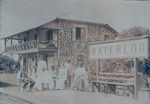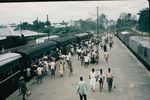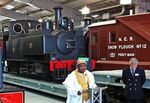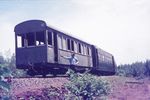The Sierra Leone Railway - A Remarkable Story of Survival
←
→
Page content transcription
If your browser does not render page correctly, please read the page content below
The Sierra Leone Railway - A Remarkable Story of Survival
The British Government started surveying Sierra Leone in 1893, with plans to build a
railway from Freetown in the west towards the Liberian border in the east, and the railway
was constructed gradually, starting in Cline Town just to the east of Freetown where the
first engine was steamed in May 1896. Regular trains began to operate to Wellington by
March 1897 and to Waterloo in October 1898.
Over the next few years, the railway
was extended eastwards, finally
reaching Pendembu, 227 miles east of
Freetown on 29th June 1908.
A branch line northwards from Bauya
to Makeni opened in February 1915.
Bauya Junction, c1955
A smaller branch, known as the Mountain Railway
was part of the Government Railway but was built
as a separate line, from the Cotton Tree in the
centre of Freetown to Hill Station in the foothills of
the mountains, where European officials lived to
avoid the malarial swamp lands on the coast.
This line was opened on 4th April 1904, but only survived until 28th February 1929 as the
passengers were among the first people in the country to acquire motor cars.Cotton Tree Station now houses the National Museum of Sierra Leone.
The first half of the Sierra Leone Railway, from the
coast, was used principally by passengers.
However, the railway was also important in
enabling farmers and traders to take their produce
to market or get foodstuffs and hardware to their
inland homes. The biggest export transported on
the railway was palm kernels, which were sent to
Europe for making into glycerine, margarine, soap
and lubricants.
The war years of 1939 – 1945 saw a revival in
railway operation but a deterioration in the track and rolling stock.
The closure of one of the mineral mines in the country also damaged the economy and the
government was forced to consider whether to continue to subsidise the railway. Air and
road transport were beginning to represent real competition and the decision was made to
phase out the railway.
Reduction in mileage began in 1968 with the closure of the Makeni branch, Pendembu to
Kenema followed in 1971, Kenema to Bo in 1973 and the final train ran on 17 November
1974.
When the railway closed in 1975, the General Manager and his team set aside a number
of locomotives and carriages which were locked in the carriage shed at Cline Town and
marked ‘NOT TO BE BURNT’.
They stayed there right through the rebel war
and everyone had forgotten they were there.
However, the collection survived despite the
workshops being used as a centre for displaced
people, with over 10,000 refugees living here at
once point. During this time, many of the
carriages were stripped of their fittings and
panelling and the locomotives had lost many of
their non-ferrous components.
In 2004 they were rediscovered by Colonel Steve Davies, a railway enthusiast on military
service in Sierra Leone.
Colonel Davies was able to bring the collection to the attention of President Dr Ahmad
Tejan Kabbah, who visited the workshops site and indicated his support for the
preservation of the railway heritage of Sierra Leone.
As a result, Colonel Davies was able to recruit a team of local men to assist in the creation
of a National Railway Museum. A major restoration programme was started in September
2004 and after months of hard work, cleaning, repairing and restoring the museum opened
to the public in March 2005 in the presence of President Kabbah and Andrew Scott, the
Director of the National Railway Museum in York, UK.However, the locomotives and rolling stock in the Sierra Leone National Raiwlay Museum are not the only remarkable survivors. At the time the railway was closing, a small railway in Mid-Wales, known as the Welshpool & Llanfair Light Railway, was in the process of being re-opened by group of enthusiastic volunteers. By coincidence the WLLR was the same gauge – 2ft 6 ins – as the Sierra Leone Railway and, hearing about the closure of the SLR, a team of volunteers travelled to Freetown to negotiate with the scrap merchants for the purchase of a working locomotive and some carriages. The locomotive selected for the WLLR was 2-6-2T tank locomotive No 85 built by the Hunslet Engine Co. Ltd of Leeds in 1954. She is the last of 32 similar locomotives built for the Sierra Leone Government Railway (SLGR) in batches between 1898 and 1954. The locomotive cost nearly £11,000, equivalent to £260,000 today, when delivered in October 1954. She has outside frames, Walschaerts valve gear, flush round topped firebox, Ross pop safety valves and lifting injectors mounted on the firebox backplate. The engine has steam and hand brakes with a vacuum ejector for train brakes. The locomotive was purchased and arrived in Llanfair Caereinion from Freetown on 7 th August 1975 via Liverpool docks. She was accompanied by four 1961 built ‘Independence’ coaches which had been built by the Gloucester Carriage and Wagon Company. With the abandonment of the SLR it was not surprising that No.85 needed a complete overhaul. She entered service as WLLR No.14 in 1979 in a green livery that was considered to be somewhat similar to that carried by SLGR locomotives before the 1939- 45 war. Her SLGR number plates were retained and this extremely popular locomotive is known on the WLLR by both numbers – sometimes together. The boiler received a heavy overhaul in 1999 and the locomotive continued in service until 2010 on the lighter service trains and driver experience turns. In 2010 the boiler was considered to be beyond economic repair and it was decided to sideline the engine for rebuilding at a future date and No.85 was loaned for display at Locomotion, the National Railway Museum at Shildon until April 2017. Now that No. 85’s time in Shildon is at an end, the locomotive is undertaking a Grand Tour around the UK, accompanied by a travelling museum exhibition, children’s activities for schools and families, plus interpretation items, and staffed by volunteers from the W&LLR and the Friends of Sierra Leone National Railway Museum. The Grand Tour is being funded with the generous support of the Heritage Lottery Fund. The first stop on No. 85’s Grand Tour was Leeds Industrial Museum, Armley Mills in Leeds, the town where the locomotive was built, followed by two weeks in Hull, City of Culture 2017, celebrating the many links between Hull and Sierra Leone. Between 27th May and 5th June No. 85 will be on display as part of the ‘African Railway Adventure’ event at the London Museum of Water & Steam at Kew Bridge, supported by the Sierra Leone museum’s UK Friends group. The locomotive will then travel to Birmingham, another city with strong Sierra Leone connections, for the 50th anniversary open weekend at Tyseley Locomotive Works on 23rd-25th June. The final stops on the Grand Tour are still being confirmed, but are expected to include a visit to Ironbridge Gorge Museum during the summer holidasy and Shrewsbury Steam Rally on 27th-28th
August before a triumphant return to the Welshpool & Llanfair a week later as part of the annual Steam Gala on 1st-3rd September. How quickly No. 85 will be restored to service will depend on the success of fund-raising for the railway’s ‘2020 Vision’ major developments project, that includes the building of a brand-new workshop, and the availability of volunteers to do the work. More details of No. 85’s Grand Tour will be published as they become available. No. 85 on display in the Locomotion Museum at Shildon, No.85 in service on the Welshpool & Llanfair, pictured here during a Sierra Leone event in 2012. with its Sierra Leone rolling stock just before withdrawal Photo: Andrew Charman/W&LLR in 2010: Photo: Andrew Charman/W&LLR Helen Ashby Chair, Friends of Sierra Leone National Railway Museum For further information please contact Helen on foslnrm@outlook.com Or visit www.sierraleonerailwaymuseum.com Follow us on: Facebook - Sierra Leone National Railway Museum and Twitter -@SLRailwayMuseum
You can also read



























































